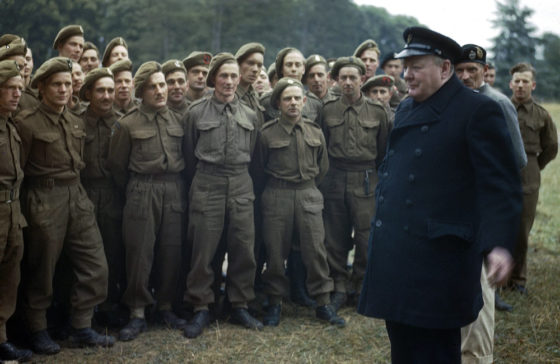
“We both had our pistols in our hands. I really thought I was going to have to shoot him.”
By Chuck Lyons
ON NEW YEAR’S Eve 1943, a full five months before D-Day, two British commandos swam ashore near the village of Luc-sur-Mer in France’s German-held Normandy region.
They were Major Logan Scott-Bowden of the Royal Engineers and Sgt. Bruce Ogden-Smith.
In the distance, the two men could hear enemy soldiers singing as they rang in the new year.
A fierce wind that had begun blowing as they crossed the English Channel had carried the duo a mile from their target landing site, a beach Allied planners of the upcoming invasion of France code-named “Sword.”
Armed with daggers and Colt 45 pistols, the two men began walking in the darkness, careful to stay below the tide line so their footsteps would be erased by morning.
“We had to creep past the searchlights to make our way to the correct beach, dropping down on our stomachs every few minutes when the search light came back round,” Scott-Bowden later said.
Scott-Bowden and Ogden-Smith were members of the Combined Operations Pilotage and Beach Reconnaissance Party (COPP), a secret British unit that had been formed after the disastrous Dieppe landing in August 1942 by Lord Mountbatten, chief of combined operations.
They were there to answer a question.
By late 1943 planning for the following year’s Allied invasion had targeted the east coast of the Cotentin Peninsula in Normandy. The region had all the factors needed for the massive operation’s success: 30 miles of coastline, shelter from the worst of Atlantic Ocean storms, suitable exits from the beaches and a good road network.
The invasion planners exhaustively studied everything they could about the region; one seemingly innocuous piece information had them concerned. Ancient maps supplied by the French Resistance indicated that centuries earlier the Romans gathered peat from the area. If there were still indeed peat bogs under the thin layer of sand at the proposed landing sites, the beaches might not be able to support the heavy equipment—tanks, trucks, bulldozers, and the like—which were vital to the invasion’s success.

A secret survey of the terrain would need to be conducted, right under the German’s noses. That’s where Scott-Bowden and Ogden-Smith came in.
When both were selected for the mission, and before they left Gosport, near Portsmouth, the two men were offered cyanide tablets to be used if they were captured and faced torture.
As the vessel carrying the two across the channel moved closer to shore near Luc-sur-Mer a gale was blowing.
A few miles from the target beach, they changed into rubber wet suits, strapped on their equipment, and transferred to a smaller hydrographical survey craft that took them to within two miles of the shore. Once in close to the beach, Scott-Bowden and Bruce Ogden-Smith jumped over the side and started swimming. Besides their other equipment, the men carried a dozen 12-inch tubes for sand samples and a special instrument, which resembled a pogo stick, to drive the devices into the ground.
Upon reaching Sword beach, Scott-Bowden and Ogden-Smith set abouts collecting samples and marking the locations from which each was taken on underwater writing tablets strapped to their arms.

Suddenly, the pair spotted a lone German sentry patrolling the dark beach. The two men flattened themselves in the sand as the guard crossed the beach to within 20 feet of them.
“We both had our pistols in our hands,” Scott-Bowden recalled. “I really thought I was going to have to shoot him.”
After a few minutes, the sentry moved on, and the two men quickly resumed collecting samples. Weighted down with the filled tubes and their other equipment, they pair to the surf and tried to swim out from the shore to their pick-up point. With the gale still blowing however, both were thrown back by the crashing waves. A second attempt to reach deeper water also failed. The two men rested in shallow water for a few minutes studying the incoming waves and timing their occurrence before being able to escape the surf and swim into calmer water. This time they made it.

After reaching safety beyond the beach Scott-Bowden suddenly froze in terror; Ogden-Smith, paddling several yards away, was shouting something. Were they in danger? Had they been spotted? No.
The sergeant was bellowing a holiday greeting to the distant enemy: “Happy New Year!”
“I swore at him,” Scott-Bowden recalled.
But then realizing the two were far enough from shore to be in danger, he joined his partner.
“[I] wished him a Happy New Year too.”
They had made it.
It was later reported they had left one of the “pogo stick” devices on the beach, but a French civilian had found it and hidden it for the duration of the war.
Scott-Bowden and Ogden-Smith had succeeded in their mission. Their work demonstrated that the beach sand was generally acceptable, but thin in a few places. The two would return the Normandy coast to conduct more surveys in the coming weeks. Both would help with the piloting of landing craft during the D-Day invasion.
Chuck Lyons is a retired newspaper editor and a freelance writer who has written extensively on historical subjects. His work has appeared in national and international periodicals, and he was the 2008 winner of the Harryman Dorsey Award for “an outstanding article on Colonial American History.” Lyons resides in Rochester, NY with his wife Brenda and a golden retriever named “Jack.”









